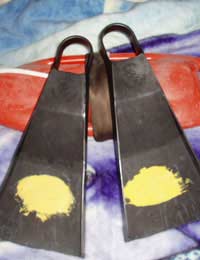Choosing Equipment to Improve Swimming Technique

As a super streamlined sport, swimming is light on equipment needs, but there are certain useful training items that can help make light work of your water borne performance.
Improve Swimming Technique and Performance
One reason why swimming is renowned as an accessible sporting activity is because equipment needs are minimal and cheap – essentially all you need for a good session is a swimsuit and a pair of goggles.Taking part is one thing but for those eager to progress beyond a regular few lengths at the local pool, equipment such as kickboards and hand paddles can be introduced to help further develop stroke technique and performance, as well as improve the efficiency of the work-out.
Brilliant technique is vital for peak performance, and so for club swimmers such equipment aids are a regular part of training drills. Nevertheless you don’t need to harbour dreams of podium glory to justify taking a training aid into the pool with you. Paddles, pull-buoys, kickboards and flippers all feature as part of a swimmer’s daily workout and are familiar sights at any local baths.
Flippers or Fins
While divers employ flippers as a more efficient fish-like substitute to their regular feet, swimmers use flippers – or fins as they’re often known - in training drills to help improve the action of their fin-free feet, as well as the rest of their body.Aside from making slow swimmers swim faster, using flippers while kicking is believed to help swimmers improve leg muscle strength and increase ankle flexibility. The resultant stronger leg kick gives the athlete an improved body position, which in turn enables them to better improve their arm stroke.
Whereas divers use big flipper blades, swimmers opt for medium or small sized fins. The small blades allow a foot speed that is slightly improved to the normal kicking speed, and the medium size offers more significant power to the leg movement.
Hand Paddles
At the opposite end of the body hand paddles can be used to instead build-up arm strength. Employing paddles to either swimming or pulling can improve speed and feel, and also help highlight any existing stroke flaws.The use of paddles adds an extra load to the workout, which is beneficial in terms of conditioning but it is also worth bearing in mind that such pressure can increase the likelihood of injury, particularly in the shoulders.
Floats: Pull-Buoys
Although commonly known for assisting non-swimmers in remaining buoyant, floats are also used by more advanced swimmers in building up muscles. They are available in a variety of shapes and sizes, but the principle float types for training aids are known as kickboards and pull-buoys.Fitting between your thighs to offer relief to the lower limbs, pull-buoys enable the swimmer to work on increasing upper body strength. They are usually made out of foam and can be broken up into two main types - solid and two piece. The solid type is not adjustable, but they do not move or shift as much as a two piece buoy. Pull-buoys with two separate floats are joined by a rope or band and can be adjusted to fit the individual swimmer’s leg size.
Floats: Kickboards
Held in the hands, kickboards allow the swimmer to rest the upper body and instead focus on the leg action. Often front crawling swimmers put too much emphasis on upper body technique to the detriment of the legs. This training aid can be used to redress this balance by helping improve kicking technique, as well as strengthening the legs and ankles.As with all these items of equipment it is important to use them merely as aids in improving normal technique and not to become too reliant on them, otherwise they will have a detrimental effect. Kickboards alter body position, for example, and so practice should maintain a balance with and without the device so that the swimmer’s technique does not grow accustomed to the temporary positioning.
Swim Benches
Swimming practice need not be confined to the water. You may have seen benches positioned at the side of the pool - these are used by swimming coaches to help teach proper swimming techniques, as well as in dry land conditioning.Full strokes can be performed on swim benches enabling coaches to identify flaws in technique, and then help to fine tune a stroke. Needless to say such attention to detail is unnecessary for all but the most committed of swimmers. Top swimmers are even known to have own bench at home so they can train without having to go to the pool.







